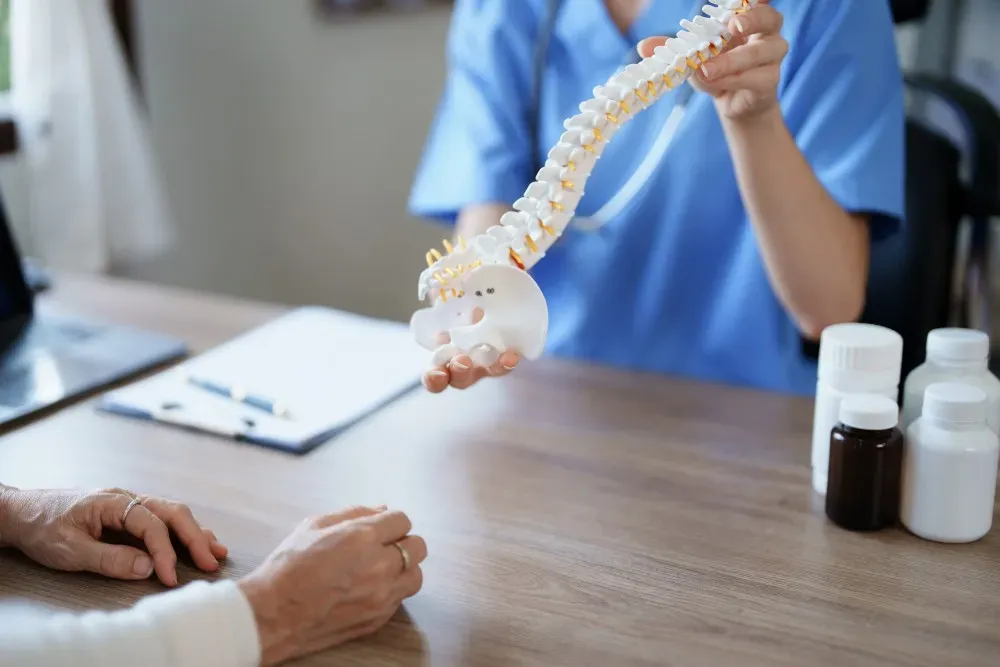Neurosurgery & Orthopedic Surgeons in Jacksonville

What is an Annular Tear?
,h2>Annular tears are back injuries that develop in the spinal discs, which sit between the 33 vertebrae of the spine. The main functions of spinal discs are to cushion the vertebrae, absorb shock and help the spine move fluidly.
WHAT IS AN ANNULAR TEAR?
Annular tears are back injuries that develop in the spinal discs, which sit between the 33 vertebrae of the spine. The main functions of spinal discs are to cushion the vertebrae, absorb shock and help the spine move fluidly. The intervertebral discs have 2 components:
- An outer ring of tough ligament fibers called the annulus fibrosus
- An inner center of jelly-like fluid called the nucleus pulposus
A tear or crack in the tough outer ring is called an annular tear. The outermost layer of the annulus fibrosus is home to many nerve fibers, so tears can result in significant back or neck pain. Annular tears are most common in the low back and neck, because the cervical and lumbar regions are the most mobile and bear the most weight.
TYPES OF TEARS AND COMPLICATIONS
There are 3 types of annular tears:
- Radial: A radial tear starts in the inner layers of the annulus fibrosus and extends outward
- Peripheral: A peripheral tear occurs on the outermost layer of the annulus fibrosus
- Concentric: A concentric tear develops in the inner layers of the annulus fibrosus around the nucleus
In some cases, annular tears cause no pain or symptoms, and you may not know you have one. However, repeated pressure on a torn, damaged disc can cause a more severe tear. Torn discs can cause further complications, like a bulging disc or disc herniation. Disc herniation occurs when the jelly-like fluid in the nucleus leaks out of the spinal disc and into the spinal column.
Annular tears may also be a sign of degenerative disc disease (DDD), a condition that develops when wear and tear on the spinal discs causes pain and other symptoms.
CAUSES AND RISK FACTORS
One primary cause of annular tears is natural disc degeneration with age. As we get older, our spinal discs dry out, stiffen and lose flexibility, which makes them more vulnerable to tears and injuries. Years of repetitive stress and pressure placed on the back can also cause aging discs to tear. Other common causes include:
- Overuse injuries from physically demanding professions that put a lot of strain on the back
- Overuse injuries from high-impact activities like playing sports and running
- Traumatic injuries from a fall, car accident or sports collision
- Acute injuries from using improper lifting or twisting techniques
- Obesity, which places excess pressure and stress on the back
SYMPTOMS
Minor annular tears may not cause any symptoms. However, engaging in activities that place a lot of stress or pressure on the back or neck can irritate a minor tear and cause low back pain, neck pain and discomfort.
Severe tears can cause significant pain due to the number of nerve fibers present. Additionally, symptoms can develop if an annular tear causes the spinal disc to bulge or herniate and press against nerves in the spinal column. Depending on the location of the tear, you may experience the following:
- Lumbar spine symptoms
-
-
- Low back pain
- Sciatic pain that radiates down the buttock and leg
- Numbness, tingling or weakness in the legs
- Loss of flexibility or movement in the back
- Muscle spasms
-
- Cervical spine symptoms
-
- Neck pain
- Numbness, tingling or weakness in the arms
- Loss of flexibility or movement in the neck
- Muscle spasms
If you have symptoms, they may worsen with movements that place more stress on the back and neck, like sitting, lifting, bending or twisting.
DIAGNOSIS AND TREATMENT OPTIONS
To make a diagnosis, your doctor will take a full medical and personal history. He or she will ask you about your pain, symptoms and past injuries or accidents. Then your doctor will perform a physical exam to observe areas of pain and test your flexibility and range of motion. Finally, he or she will order imaging tests like an X-ray, MRI and CT scan to rule out other conditions that might cause pain. A MRI or CT scan will reveal the presence of an annular tear.
Many annular tears heal on their own with conservative treatments. Your doctor may recommend the following treatments to promote natural healing and provide pain relief.
1.) Rest. If you’re experiencing pain and symptoms, rest and modify activities that place pressure on the injured disc. You may also find pain relief using hot and cold compresses to reduce soft tissue inflammation and ease pain.
2.) Medications. Over-the-counter NSAIDs can help ease mild to moderate pain and inflammation. If you’re experiencing severe pain, your doctor may prescribe stronger anti-inflammatory medications or nerve pain medications. If you’re having muscle spasms, your doctor can also prescribe muscle relaxants.
3.) Cortisone injections. An injection of corticosteroids directly into the injured area can temporarily reduce pain and inflammation. Although the effects aren’t permanent, a cortisone shot will relieve the pain enough for you to participate in beneficial physical therapy and allow your body a chance to start healing.
4.) Physical Therapy. Physical therapy can help you improve strength, flexibility and range of motion in your back to protect it from injury. Exercises can also help you build up core strength and the muscles in your core help stabilize, support and protect your back and spine.
If conservative treatment isn’t effective, you may need spine surgery. Some surgical options include repairing, partially removing or replacing the damaged spinal disc. Today, there are many spine surgery options that are minimally invasive and have fewer risks than open surgery.
TIPS FOR PREVENTION
Once you’ve developed an annular tear, you’re at a higher risk for developing future tears and damage. There are steps you can take at home to keep your back healthy and strong, and lower your chances of injury. Maintaining a healthy weight, exercising regularly and building up core strength are 3 of the most important ways you can protect your back and lower your chance of injury or re-injury.
INTEGRITY SPINE AND ORTHOPEDICS TREATS SPINE AND JOINT CONDITIONS
Degenerative changes in the spine can cause chronic back pain, loss of mobility and other disabilities that hinder your quality of life. At Integrity Spine and Orthopedics, we offer a range of treatments to relieve pain for acute and chronic back, spine, joint and soft tissue conditions. Our board-certified doctors specialize in orthopedic care, pain management and minimally invasive spinal surgeries.
Let’s get you back to doing the activities you love. Call us at 904-456-0017 or fill out an online contact form to schedule an appointment. We also offer free MRI reviews to qualified patients.




